Population Ageing and the Well-Being of Older Persons in Thailand ...
Population Ageing and the Well-Being of Older Persons in Thailand ...
Population Ageing and the Well-Being of Older Persons in Thailand ...
Create successful ePaper yourself
Turn your PDF publications into a flip-book with our unique Google optimized e-Paper software.
Executive Summary<br />
Introduction<br />
<strong>Population</strong> age<strong>in</strong>g is occurr<strong>in</strong>g <strong>in</strong> much <strong>of</strong> Asia. In<br />
Thail<strong>and</strong> where fertility rates have fallen sharply over<br />
<strong>the</strong> past decades, this process is recent <strong>and</strong><br />
pronounced. Thail<strong>and</strong> is particularly fortunate <strong>in</strong><br />
hav<strong>in</strong>g a series <strong>of</strong> nationally representative surveys <strong>of</strong><br />
<strong>the</strong> older population that permit determ<strong>in</strong><strong>in</strong>g<br />
important trends <strong>in</strong> <strong>the</strong> well-be<strong>in</strong>g <strong>of</strong> <strong>the</strong> older age<br />
population <strong>and</strong> an up-to-date assessment <strong>of</strong> <strong>the</strong>ir<br />
current situation. In this report, we exam<strong>in</strong>e <strong>the</strong> demography<br />
<strong>of</strong> age<strong>in</strong>g <strong>in</strong> Thail<strong>and</strong>, explore <strong>the</strong> health<br />
<strong>and</strong> social <strong>and</strong> economic well-be<strong>in</strong>g <strong>of</strong> <strong>the</strong> older<br />
population, <strong>and</strong> describe government policies <strong>and</strong><br />
programmes related to population age<strong>in</strong>g. Particular<br />
attention is given to differences <strong>in</strong> relation to age,<br />
gender <strong>and</strong> place <strong>of</strong> residence (urban or rural).<br />
Demography <strong>of</strong> age<strong>in</strong>g<br />
As a result <strong>of</strong> an exceptionally rapid decl<strong>in</strong>e <strong>in</strong><br />
fertility <strong>in</strong> which <strong>the</strong> total fertility rate fell from above<br />
6 <strong>in</strong> <strong>the</strong> 1960s to its current level below replacement,<br />
Thail<strong>and</strong> is undergo<strong>in</strong>g an extensive process <strong>of</strong><br />
population age<strong>in</strong>g. Changes <strong>in</strong> <strong>the</strong> age structure will<br />
be pr<strong>of</strong>ound <strong>and</strong> <strong>the</strong> growth <strong>of</strong> <strong>the</strong> older age<br />
population truly dramatic. From a situation prior to<br />
<strong>the</strong> fertility transition when older persons constituted<br />
only 5 per cent <strong>of</strong> <strong>the</strong> population, more than one <strong>in</strong><br />
four Thais are likely to be age 60 or older with<strong>in</strong> just<br />
a few decades from now. Moreover, <strong>in</strong> just a little<br />
more than ano<strong>the</strong>r decade, persons age 60 <strong>and</strong> older<br />
will exceed those under age 15 for <strong>the</strong> first time <strong>in</strong><br />
Thail<strong>and</strong>’s history. This pace <strong>of</strong> population age<strong>in</strong>g is<br />
many times faster than experienced historically <strong>in</strong> <strong>the</strong><br />
West. Moreover, <strong>the</strong> older population itself is age<strong>in</strong>g<br />
<strong>and</strong> <strong>the</strong>re is a pronounced sex imbalance with women<br />
greatly outnumber<strong>in</strong>g men especially among <strong>the</strong><br />
oldest old. With<strong>in</strong> Thail<strong>and</strong>, <strong>the</strong> flow <strong>of</strong> young adults<br />
from rural to urban areas comb<strong>in</strong>ed with many<br />
migrant to cities leav<strong>in</strong>g <strong>the</strong>ir young children <strong>in</strong> <strong>the</strong><br />
care <strong>of</strong> <strong>the</strong> rural gr<strong>and</strong>parents has resulted <strong>in</strong> higher<br />
concentrations <strong>of</strong> both children <strong>and</strong> elderly <strong>in</strong> <strong>the</strong> rural<br />
compared to urban areas. The population <strong>in</strong> <strong>the</strong> most<br />
economically productive ages relative to that <strong>in</strong><br />
elderly ages where economic dependency is common<br />
is virtually certa<strong>in</strong> to decl<strong>in</strong>e to only a fraction <strong>of</strong> what<br />
it has been <strong>in</strong> <strong>the</strong> recent past. Thus <strong>the</strong> provision <strong>of</strong><br />
material support for older persons will take on quite a<br />
different dimension than has been or currently is <strong>the</strong><br />
case. Likewise, given <strong>the</strong> far greater likelihood <strong>of</strong><br />
serious health problems among older persons<br />
compared to <strong>the</strong> rest <strong>of</strong> <strong>the</strong> population, pressures on<br />
health facilities <strong>and</strong> services will <strong>in</strong>crease enormously.<br />
In brief, <strong>the</strong>se demographic developments will have<br />
important consequences for families, communities,<br />
<strong>and</strong> Thai society as a whole.<br />
Demographic, social <strong>and</strong> economic<br />
characteristics<br />
The social <strong>and</strong> economic pr<strong>of</strong>ile <strong>of</strong> today’s elderly <strong>and</strong><br />
trends over <strong>the</strong> recent past as presented <strong>in</strong> this report<br />
are encourag<strong>in</strong>g <strong>in</strong> several respects. Significant<br />
improvement <strong>in</strong> <strong>the</strong> material well-be<strong>in</strong>g <strong>of</strong> <strong>the</strong> older<br />
population has clearly occurred. Compared to just a<br />
little over a decade ago, older Thais <strong>in</strong> 2007 live <strong>in</strong><br />
households with far more appliances <strong>and</strong> amenities<br />
that make daily life more convenient. Their<br />
households are also more likely to have a motorized<br />
vehicle mak<strong>in</strong>g meet<strong>in</strong>g transportation needs easier.<br />
Particularly dramatic is <strong>the</strong> rapid <strong>and</strong> recent spread <strong>of</strong><br />
telephones, especially mobile phones, a development<br />
that greatly improves <strong>the</strong> ability <strong>of</strong> elderly <strong>and</strong> <strong>the</strong>ir<br />
children <strong>and</strong> relatives who live elsewhere to ma<strong>in</strong>ta<strong>in</strong><br />
contact with each o<strong>the</strong>r. This not only contributes to<br />
social well-be<strong>in</strong>g but facilitates seek<strong>in</strong>g assistance at<br />
times <strong>of</strong> health emergencies or when o<strong>the</strong>r critical<br />
situations arise.<br />
ix















